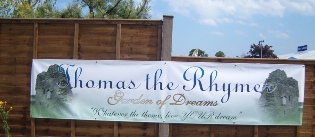
Dowles-Howden Limited ©2011 - 2019 The Friends of Thomas The Rhymer Society
Much fiction has been written about his life, and many legends abound in folk-lore. His disappearance for seven years with the "Faery Queen'" has been well publicised in books, poems, plays and music, but the factual aspect of Thomas's role in Scottish history is even more important.
There is documentary evidence of the 'Bemersyde Charter' being signed and witnessed by Thome Rymor de Ercildoune, c1270. This charter claims that Petrus De Haga of Bemersyde had promised to give ten salmon per year to the Chapel of St. Cuthbert at Old Melrose, and is changing it to half a stone of bees-wax.
The Rhymer's chapbook of poems and prophesies was kept in almost every farm-house in Scotland for centuries after his death. His prophesies were documented in English Prophetic writings in the 15th and 16th centuries. His work inspired many famous authors, Sir Walter Scott, James Hogg, John Veitch, and John Leyden, to name a few. Mikhail Lermontov (1814-1841), one of Russia's most famous poets, wrote;
"Beneath the curtain of mist, beneath a heaven of storms, among the hills of my Scotland, lies the grave of Ossian.
The surname of Lermontov began in Scotland as Learmont. The origin of the name can, supposedly, be traced back to Ercildoune.
The Rhymer's name is associated with place names and clubs in the village to this day. The High School and many local groups use the Tower as part of their logo.
The story of the “Rhymer’s Thorn Tree” goes back many centuries. Thomas predicted; "This thorn tree, as long as it stands, Ercildoune shall possess a' her lands". In 1814, the tree was cut down by the owner of the premises now known as the 'Black Bull Inn,' and subsequently died. The same year all the Merchants in Earlston went bankrupt. In 1830 the ground on which the tree stood, came into the possession of John Spence, a writer, who built a high wall round the garden, leaving a square opening at the top to mark the site of the tree.
In the east wall of the present church is a stone tablet with the inscription; 'Auld Rymr race, lyees in this place'. There have been at least five churches on the present site. The stone tablet was transferred to the present Victorian style red sandstone church in 1892. It had been transferred to the previous church when it was built in 1736. There is no record of its source prior to this date.

